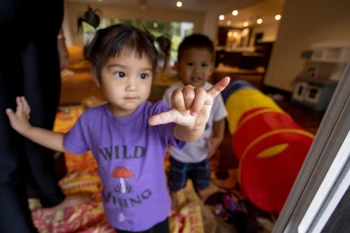The “shaka” gesture, originating from the beautiful islands of Hawaii, holds a deep cultural significance that extends far beyond a simple hand gesture.
While it may be commonly associated with surf culture and the laid-back lifestyle of the islands, its roots run deep in the daily lives of the people of Hawaii.
This iconic gesture, characterized by extending the pinky and thumb while curling down the remaining fingers, embodies a plethora of warmhearted sentiments, from greetings and farewells to expressions of gratitude and aloha, encapsulating the essence of the Hawaiian spirit.
Recently, the shaka has gained recognition and popularity beyond the shores of Hawaii, finding its way into various cultures and communities worldwide.
Its universal appeal lies in its ability to convey a sense of friendliness, warmth, and aloha spirit, making it a versatile and widely understood gesture of goodwill.
The proposal of two bills in the state Legislature to designate the shaka as the official gesture of Hawaii and acknowledge the islands as its birthplace reflects the deep-rooted cultural significance and pride associated with this simple yet powerful hand gesture.
Sen. Glenn Wakai’s optimism regarding the smooth passage of this measure underscores the widespread acceptance and reverence for the shaka among the people of Hawaii.
The nuances and variations in the way the shaka is presented highlight the rich tapestry of traditions and customs within Hawaii.
While some emphasize the importance of a simple extended pinky and thumb without any shaking, others incorporate subtle movements or variations based on regional customs and personal preferences.
Whether it’s the gentle sway of the hand or the firm, unwavering presentation of the shaka, each variation carries its own unique meaning and significance.
The shaka’s ability to defuse tension, convey gratitude, greet others, or simply share the aloha spirit has made it a beloved symbol of unity and positivity, especially during challenging times such as the early days of the COVID-19 pandemic.
Its role in diffusing conflicts, expressing respect, and fostering a sense of camaraderie among individuals underscores its enduring relevance and importance in Hawaiian culture.
As state Rep. Sean Quinlan aptly describes, the shaka is a versatile gesture that transcends language barriers and cultural divides, embodying the spirit of aloha and camaraderie that defines the Hawaiian way of life.
Residents of Hawaii, like Rep. Jeanné Kapela, recognize the shaka as a visual symbol of sharing aloha with one another, fostering a sense of community and connection among its people.
In conclusion, the shaka gesture stands as a timeless symbol of warmth, friendship, and unity, embodying the essence of the aloha spirit that defines the Hawaiian culture.
Its recognition as the official gesture of Hawaii serves as a testament to its enduring legacy and cultural significance, transcending borders and boundaries to spread a message of goodwill and positivity to all who encounter it.
The iconic gesture known as the shaka holds a special place in the hearts of many, particularly in Hawaii where its roots lie deep in the island’s culture and history.
The story of the shaka’s origin is often attributed to a Native Hawaiian fisherman named Hāmana Kalili, a figure whose legacy continues to resonate through generations.
Kalili, who lost three fingers in a tragic sugar mill accident, inadvertently sparked a gesture that would eventually become a symbol of camaraderie and aloha spirit.
According to the prevailing narrative, after the accident, Kalili found work as a guard on a train. Children seeking a free ride on the train would mimic Kalili’s hand by curling their middle fingers, a gesture that became a signal for other train-jumpers that it was safe to proceed.
This simple act of imitation, born out of compassion and solidarity, gradually evolved into the widespread adoption of the three-finger-less wave that we now know as the shaka.
As the shaka gained popularity, particularly following the waves of tourists that arrived in Hawaii after World War II, its usage expanded beyond the island’s shores.
The gesture became synonymous with the surfing culture of the 1950s and ’60s, spreading globally and finding its way into various facets of life.
From sports to everyday interactions, the shaka has transcended its origins to become a universal symbol of positivity and connection.
In present-day Hawaii, the shaka is ingrained in the fabric of society, so much so that its presence is often taken for granted.
It is a gesture of appreciation, gratitude, and community, seamlessly integrated into daily interactions. Whether it’s a bus driver thanking a motorist with a digital shaka light or individuals using the gesture to express their island roots while abroad, the shaka serves as a unifying symbol for the people of Hawaii.
Businesses have also embraced the shaka as a means of projecting a sense of belonging and inclusivity within the community.

From naming products and services after the gesture to incorporating it into branding and marketing strategies, the shaka has become a powerful tool for fostering connections and promoting a sense of shared identity among locals and visitors alike.
In a world where gestures can often be misinterpreted or carry negative connotations, the shaka stands out as a beacon of positivity and goodwill.
Its origins may be rooted in a simple act of mimicry, but its impact has transcended boundaries, bringing people together and spreading a message of unity and aloha wherever it goes.
As the shaka continues to evolve and adapt to new contexts, its essence remains unchanged—a symbol of friendship, compassion, and the enduring spirit of Hawaii.
